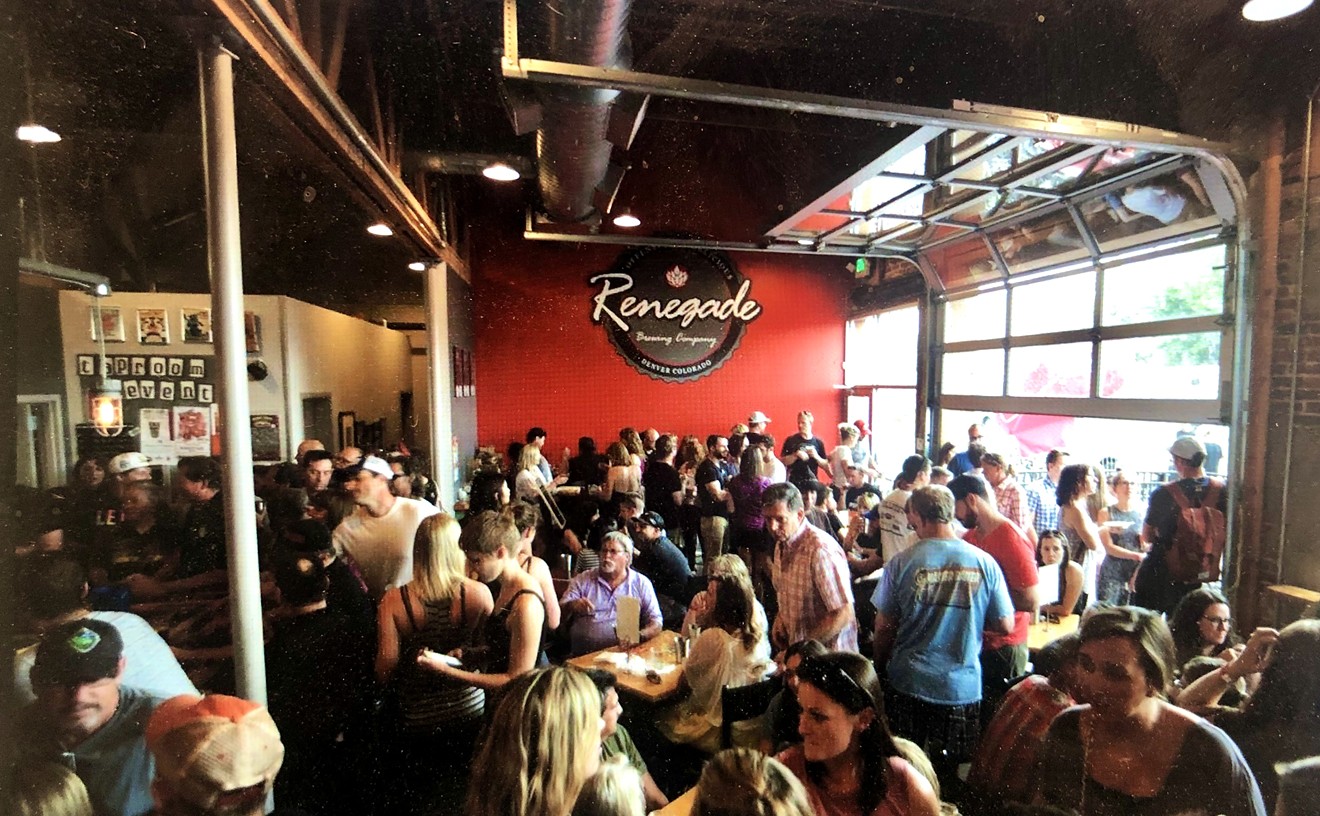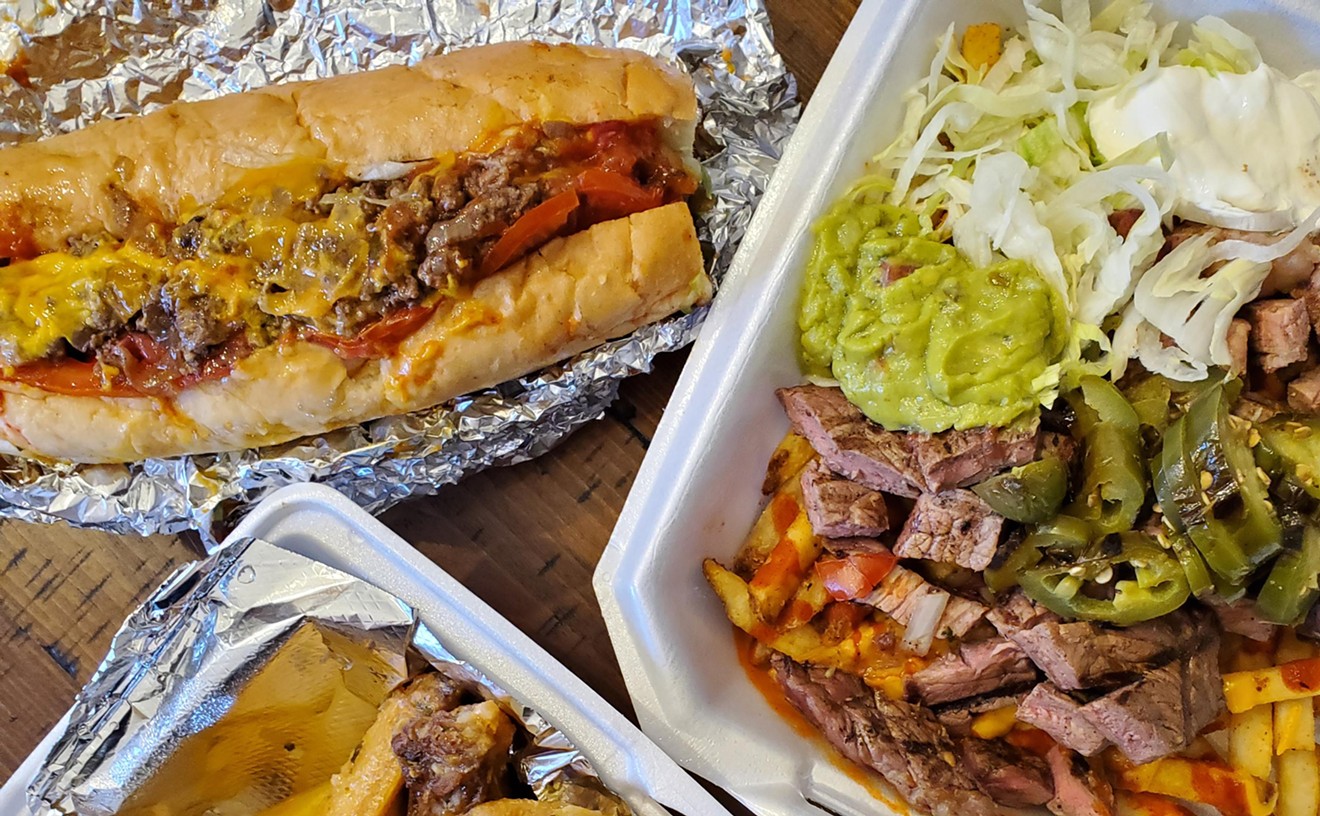I've been here before, and it was even quieter then -- because as it turned out, Cuba Libre had dumped its lunch service without warning, leaving me stranded on the far side of Littleton with a hunger for fried plantains and rum-soaked barbecued ribs and nowhere to go.
So this time, I'd called before making the drive to make sure the restaurant hadn't decided to cancel dinner service as well, and to ask if I needed a reservation and how late the place would be open. The girl on the phone politely told me that a reservation wouldn't be necessary and that she wasn't sure how late Cuba Libre would be serving. She said it depended on whether anyone showed up. It had been slow for the last couple of days, she explained, but they were expecting things to pick up again soon.
Now, as Laura and I get out of the car, we do detect some signs of life. Soft light spills out onto the sidewalk, and I can hear muffled accordion music. We step inside, and the space is warm, welcoming, huge -- the kind of size you feel as a falling-away of perspective, skin tingling at the sudden sensation of needing to be much larger just to fill the available area. I won't even guess at its maximum capacity, because Cuba Libre is so big there's no one place you can stand or sit and see the whole space -- unless maybe you're hung on wires from the distant ceiling. There are two floors (three, if you count the I Zen sushi bar in the basement, and I'm not, because out of sight, out of mind), but the first has no ceiling, which creates a mezzanine area on the second floor, a balcony-style arrangement running around the pit of the bar, the open space rising way up to the raw-wood rafters, up to a vaulted ceiling that's painted red and covered with twisty water pipes and HVAC ductwork. The main dining room is carved up into two sections -- booth seating along the walls and table seating around the bar -- and there are staircases and railings, potted plants, pictures hung crooked on the walls, and very cool, very antique-looking fans with woven paddles in place of blades and belt-driven motors to keep them turning. It's custom work, and a very nice touch. Owners Inhui Oh and Russel Evans picked up the shell of this building when it was still only half done, and I cannot imagine what it cost them to finish it, what they paid for the faux-antique fan mechanisms and what kind of premium they must have shelled out to the plumbers who ran the water lines up to that cathedral ceiling to bring the sprinkler system up to code.
It's a shame that only a dozen people are in the house to appreciate all this good work -- and that includes the two hostesses crowding each other at the stand, huddled over a book devoid of reservations and a large stack of hardbound menus, and a bartender craning her neck to read the closed-captioning on the expensive flat-screen TVs hung over the bar.
Big spaces will always be crippled by a lack of bodies. That's just geometry. Or physics. Whatever. In a small place, three seated parties might make a dining room feel cozy, even intimate, to a fourth just entering. But in a big room, three tables make the space feel even emptier than if there were none. And even if Cuba Libre were half full, it would still feel almost empty. Laura and I are seated in a plush, upholstered booth against the wall, with windows looking out across the patio (another dozen-odd tables there) and down the hill at Applebee's. We are given water, menus, wine lists. It's odd that cocktails aren't listed anywhere -- just wines, by the glass and by the bottle -- but our server makes suggestions. We order beer and mojitos, trying to get in the mood, trying to give the bartender something to do. And then we start looking over the menu.
It's a great menu, full and well-rounded. Like the best menus -- the ones written by Pepin and Waters and Waxman and that lot -- it reads like poetry, full of allusion and metaphor and a whole lot of words I don't know. There is evidence of rigorous French training and an understanding of Cuban cuisine both as it exists today and as it could exist if not for the fact that Cuban culinary history pretty much stopped on the island around 1959. It is fusion in the best possible way, fusing Cuban food not with some other cuisine, but with an imagined version of itself, and it is as interesting a board of fare as I have seen in quite a while. It is also expensive -- but at Cuba Libre, we soon learn, you get what you pay for.
We order, working our way through tapas, ceviches, escabeches (ceviche that's been flash-seared) and entrees both authentic and nouvelle. Our server is right there with us, making intelligent suggestions and capably answering any question we put to him, including the only one that really matters.
"It's quiet in here tonight," I say. "Is it always like this?"
"No," he replies. "It's just been for the last couple of days. But things will probably pick up again soon."
I make a mental note to give him a good tip, paying for his high hopes. There's nothing worse for a server than a night in a dead restaurant, nothing so boring, no place where time moves slower.
The lobster ceviche is a Ferris Bueller kind of dish, one of those "if you have the means" situations, offering medallions of lobster tail dressed with chunks of claw meat, marinated in a powerful citrus wash, garnished with orange slices, chives and microgreens, and laid out on the plate in the shape of a flower. It is beautiful, edible art -- not something I'm usually into -- but since this tastes much better than a bite of the "Mona Lisa," I'm able to let that go. We eat empanadas wrapped in puffed, perfectly browned phyllo, stuffed with a chile-marinated chicken-and-pork pâté that would be right at home on any French charcuterie board, and served with a squiggle of cilantro aioli. We follow that with pork croquets, perfectly spherical, breaded and deep-fried, with an interesting flavor that's layered with a luxurious fattiness and punctuated by bell pepper and a half-dozen herbs working in concert.
The croquets are served on a smear of black-bean purée with roasted, smoked and garlic-spiked quarters of plum tomato as a garnish. That's a lot of trouble to go through for a garnish -- a complicated progression of kitchen tricks that certainly took longer than making the croquets themselves. But far from being an anomaly on this menu, such attention to the little details defines it. The pork chops, glazed in a biting orange sauce, come with a corn-and-mushroom flan, the red snapper with a plantain crust, mashed avocados with smoked tomato coulis and yucca latkes. The Cuban tamales (one pork, one chicken, both with corn, the chicken subtly sweet and delicious, the pork too dry) arrive with a seared rice, black-bean and kidney-bean concoction called congris and a wicked lime-and-chile sauce that's like liquid key lime pie set on fire.
The kitchen makes its own chorizo, mashed flat like a sausage patty and seared hot so that it goes crisp around the edges and tastes like Slim Jims. The ropa vieja is admirably authentic -- slow-cooked brisket in a thin, sharp tomato sauce that the menu calls a demi but is actually more like a water-thinned barbecue sauce. The meat is wonderful, smoky and tender, and served with a chayote slaw that I'm already too full to eat. I just push around the shrimp-stuffed calamari, which are breaded in panko but overcooked and rubbery, barely edible. The sweet chile sauce on the side is excellent, though; I dip the rest of the croquets in it and am a very happy man.
Our server has described the cumin-mustard rack of lamb in a way that makes it impossible not to order it, and he's not exaggerating its goodness. The gigantic square plate holds three double-cut lamb lollipops cooked a perfect, bloody rare, crusted in toasted almonds, the bones frenched. They are set upright, balanced on each other's backs, over a slash of sautéed spinach; the corners of the plate are decorated with twirls of roasted-garlic custard so delicate and subtle and absolutely delicious that I want to take a bucket of it home. Why has no one thought of a garlic custard before? It's so much cooler than an aioli. I could do without the onion-yucca churros, though, which are starchy, heavy and dressed in a honey coating that's not doing them any favors.
Laura has stuffed chicken breast filled with manchego and serrano, set in a tarn of sherry-mushroom sauce so ideally composed and so very, very French that I'm surprised it doesn't come to the table wearing a beret. There are taro frites on the side, and Laura doesn't like taro, but she eats most of the frites anyway, running them through the sauce with her fingers. When I reach for one, she gets a look in her eye like she might stab me. I order her another mojito and we move past it.
There's Cuban music echoing around the room, lots of sad fiddles and accordions interspersed with booming laughter from the one table seated up on the second floor -- a big party being attended to by a constantly rotating squad of servers carrying drinks and plates and fresh napkins. Meanwhile, the kitchen is shedding white-jackets like there's a kegger in the parking lot. I count two, then three, then four guys sent home. The bartender is watching sitcoms. Other than a guy in the bar reading a newspaper and picking at his tapas, Laura and I are now the only table on the main floor.
It's a good dinner -- a bit lonely, but with excellent food and service.
A few days later, I call Inhui Oh to ask her about the menu and the chef who created it, about the restaurant and her own background. The six-month-old Cuba Libre (and I Zen downstairs) is Oh's second restaurant. She ran a sushi bar in Aurora previous to this, considers her place in life to be in restaurants and in kitchens. But this is Russel's first time in the game. The chef, John Daly III, came from an exec's post at Wolfgang Puck's joint downtown, and from the country-club circuit before that. He's a culinary-school guy with no gut-level understanding of Cuban food other than what he picked up from books, but apparently he read a lot of books. Considering that he's cooking a cuisine that doesn't actually exist, his education wasn't wasted. Oh recognizes that, explaining that Daly has tried to create a menu that presumes what might have happened had Cuban cuisine developed unfettered into 2006. I say I think he nailed it, that I had a great time and great food but am a little concerned by the lack of customers.
"Really?" she asks, her accent thick. "When did you come in?"
I tell her, and she says I should've been there last weekend. The place was packed, standing-room only, forty-minute wait at the door. Weekends -- most weekends, anyhow -- are busy. So I ask about weeknights.
"Slow," she says. "Sometimes slow. But they're getting better." She mentions the Applebee's across the street, how it is always full, how she thinks the people out in this end of Littleton deserve better.
"Our heart is here," she says. "That's why we're here. Things will pick up soon."










